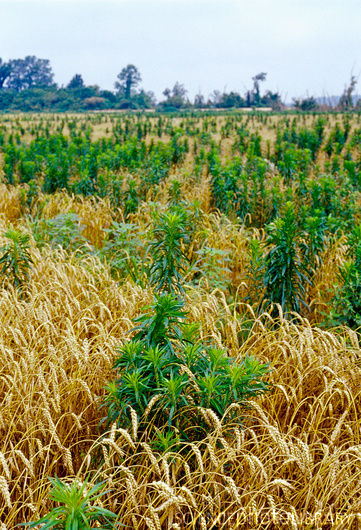
Agricultural News
Tank-Mixing Herbicides to Improve Weed Control in Winter Wheat
Wed, 21 Dec 2011 14:38:39 CST
 Tank-mixing multiple herbicides is a simple way to broaden the spectrum of weeds that can be controlled in a single application. According to Joe Armstrong, Small Grains Weed Science Extension Specialist, in addition to improving weed control, tank-mixing herbicides from multiple modes of action is also an important step in the prevention and management of herbicide-resistant weeds.
Tank-mixing multiple herbicides is a simple way to broaden the spectrum of weeds that can be controlled in a single application. According to Joe Armstrong, Small Grains Weed Science Extension Specialist, in addition to improving weed control, tank-mixing herbicides from multiple modes of action is also an important step in the prevention and management of herbicide-resistant weeds.
For example, Kansas has found several populations of ALS-resistant winter broadleaves, such as marestail, bushy wallflower, and flixweed (pictured below). In all situations, these weeds were resistant to several ALS inhibitor herbicides, such as Finesse®, Ally®, Amber®, Olympus®, PowerFlex®, Express®, and Beyond®. While ALS-resistant broadleaf weeds may not be currently prevalent in Oklahoma, it is extremely important to take pro-active steps to prevent their development.
One of the easiest and most effective ways to integrate resistance management practices is to tank-mix products from additional herbicide modes of action, such as MCPA, 2,4-D, dicamba, Huskie®, or Aim®. For more information on herbicide mode of action, please see the OSU Fact Sheet PSS-2778 "Herbicide How-to: Understanding herbicide mode of action."
While most herbicides can be safely tank-mixed with one another, there are some situations where the combination of two or more herbicides may have a detrimental effect on the herbicide's performance or increase the potential for crop injury. The most common example of this is when an ALS inhibitor herbicide is applied with an organophosphate, or "OP," insecticide (Group 1B) causing severe crop injury.
Before mixing any herbicides or other agrichemicals, it is important to read each product's label and check for specific information regarding compatibility, use rate, and recommendations for adjuvants and/or surfactants.
Our thanks to Joe Armstrong for this article over mixing herbicides. This article was part of the Plant and Soil Sciences Extension News.
WebReadyTM Powered by WireReady® NSI
Top Agricultural News
More Headlines...



















